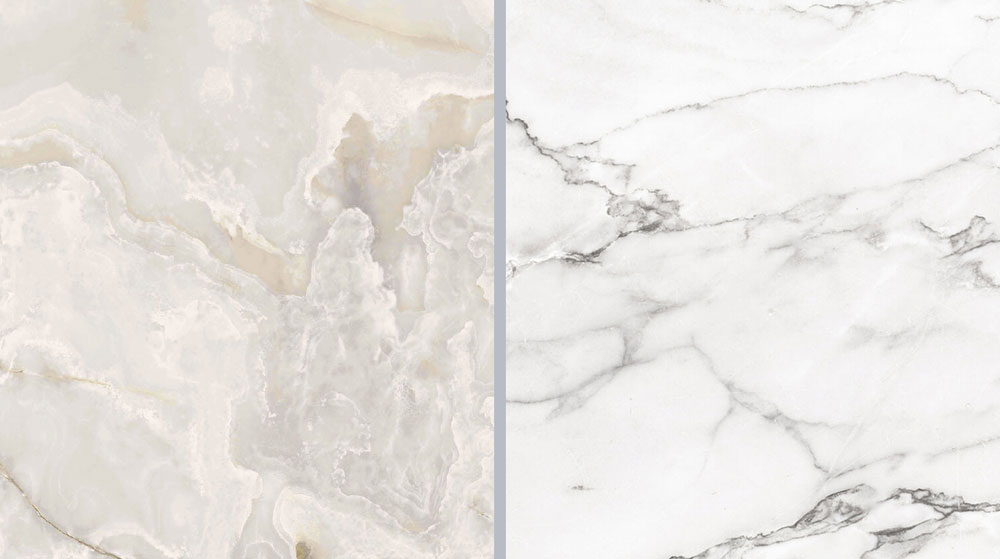
Marble VS Onyx
Marble and onyx stone are stones of natural origin that have been used for centuries in various fields, including architecture and sculpture. These two stones are similar, but they also have differences that we will discuss further.
Uses (marble and onyx)
Because of their charm, marble and onyx have been used for centuries in various applications. Marble is usually used as floor coverings, tables, fireplace surrounds, statues and decorative elements in various buildings.
With its unique translucent properties, marble is often used for backlit applications such as wall panels, retaining walls, decorative countertops, and lighting fixtures. When light passes through this stone, it creates a stunning visual effect, a feature that has fascinated architects and designers for centuries.
Marble and onyx structure

Marble is a metamorphic stone composed primarily of recrystallized carbonate minerals, usually calcite or dolomite (formed when limestone is exposed to extreme heat and pressure over time).
Onyx stone is a type of cryptocrystalline quartz that is formed in cavities caused by lava flows or as stalactites and stalagmites in caves.
Resistance and durability
When it comes to durability and hardness, marble tops onyx, depending on its type and composition, marble has a hardness of 3 to 5 on the Mohs scale, meaning it can withstand wear and moderate pressure. but if not maintained properly, it is prone to scratches and stains. onyx also has a lower hardness of about 6-7 on the Mohs scale, which makes it prone to scratching and breaking.
Minerals that make up marble and onyx
The composition of onyx is mainly composed of silicon dioxide (SiO2), which is responsible for its glassy appearance, it also contains various mineral impurities such as iron oxide, manganese oxide or carbon compounds, which have different colors and visible streaks. These impurities create a wide variety of onyx colors, including white, black, green, red, and brown.
Marble is composed of calcium carbonate (CaCO3), which is obtained from the main precursor of limestone. The presence of other minerals such as clay minerals or quartz can affect its appearance and durability. The vein patterns that can be seen in marble are caused by impurities in the ingredients or iron oxide that is present in the marble.
Physical characteristics of onyx and marble
Onyx is known for its translucent properties, which allow light to pass through the stone. You have probably seen an example of this phenomenon in the decor of stores or luxury homes. This unique feature makes it an excellent choice for decorative purposes such as countertops or wall panels that can create stunning visual effects, however, onyx is relatively softer than marble and is more prone to scratching or etching with acidic substance.
Marble stone has a distinct crystal structure, which makes polishing processes especially possible on it. After polishing, this stone reaches a high shine and is suitable for all kinds of decorative and covering uses. At the same time, its resistance makes it maintain this brightness over the years.
Marble is famous for its durability, And this feature makes it suitable for various applications such as flooring, sculptures and architectural elements. However, marble is a porous stone and is prone to staining if not maintained properly.
Physical features

One of the most noticeable differences between marble and onyx lies in their appearance, marble usually has a vein pattern with colors ranging from white to black, including gray, beige, pink, green or blue (these veins are due to impurities that builds up over time).
Onyx has a transparent quality with bands or layers of different colors running through it. These bands can range from white to shades of brown, red, yellow or green.
Conclusion
While marble and onyx are both natural stones with their own distinctive beauty, they have differences in terms of composition, appearance, durability and use.
Marble is known for its veined patterns and greater strength, making it suitable for a wide range of applications. Onyx’s transparent quality and unique color bands, on the other hand, make it ideal for backlit installations or spots where its striking appearance can be used.
Ultimately, choosing between marble and onyx comes down to personal preference and specific project needs.
If you are looking to use sunlight or use its brilliance in a building, onyx stone is probably a serious choice for you, and if you are looking for a durable yet transparent and polished finish, marble is a great option for you.
